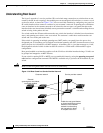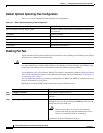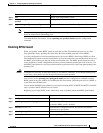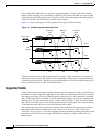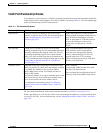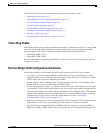
13-20
Catalyst 2950 Desktop Switch Software Configuration Guide
78-14982-01
Chapter 13 Configuring Optional Spanning-Tree Features
Configuring Optional Spanning-Tree Features
To disable root guard, use the no spanning-tree guard interface configuration command.
Enabling Loop Guard
You can use loop guard to prevent alternate or root ports from becoming designated ports because of a
failure that leads to a unidirectional link. This feature is most effective when it is configured on the entire
switched network. Loop guard operates only on ports that are considered point-to-point by the spanning
tree.
Note You cannot enable both loop guard and root guard at the same time.
You can enable this feature if your switch is running PVST or MSTP. The MSTP is available only if you
have the EI installed on your switch.
Beginning in privileged EXEC mode, follow these steps to enable loop guard:
To globally disable loop guard, use the no spanning-tree loopguard default global configuration
command. You can override the setting of the no spanning-tree loopguard default global configuration
command by using the spanning-tree guard loop interface configuration command.
Step 5
show running-config Verify your entries.
Step 6
copy running-config startup-config (Optional) Save your entries in the configuration file.
Command Purpose
Command Purpose
Step 1
show spanning-tree active
or
show spanning-tree mst
Determine which ports are alternate or root ports.
Step 2
configure terminal Enter global configuration mode.
Step 3
spanning-tree loopguard default Enable loop guard.
By default, loop guard is disabled.
Step 4
end Return to privileged EXEC mode.
Step 5
show running-config Verify your entries.
Step 6
copy running-config startup-config (Optional) Save your entries in the configuration file.



